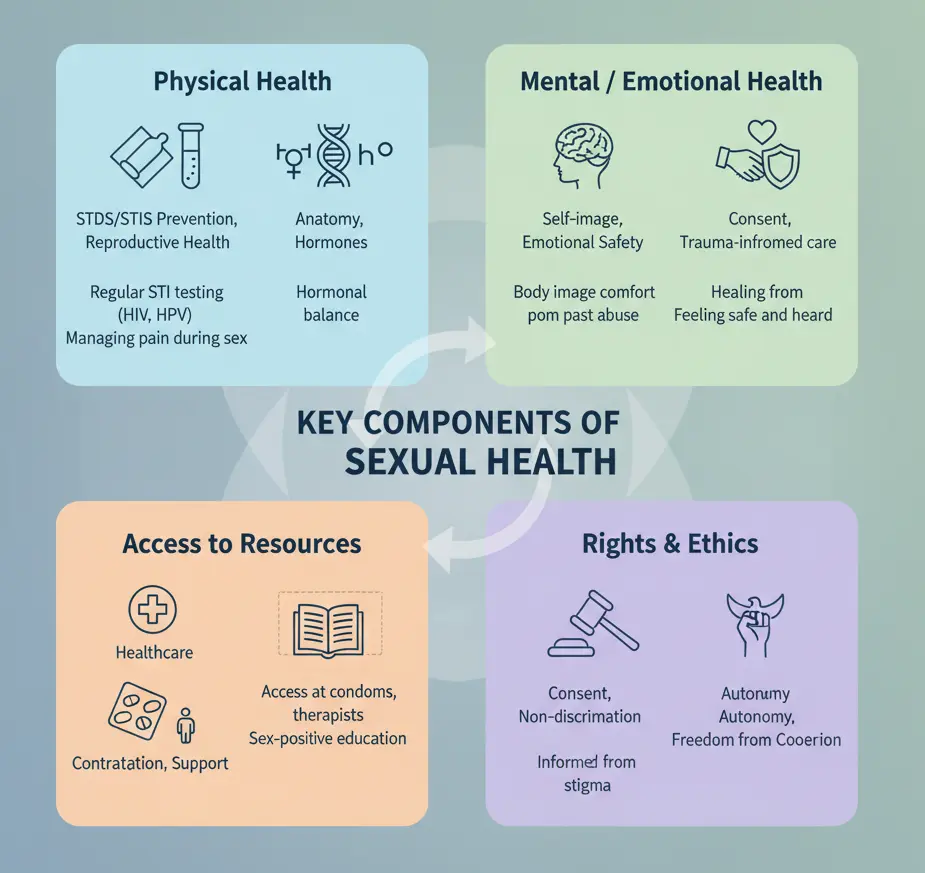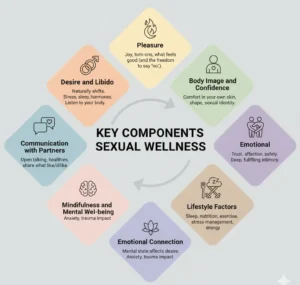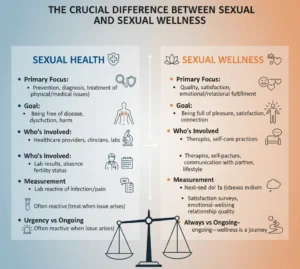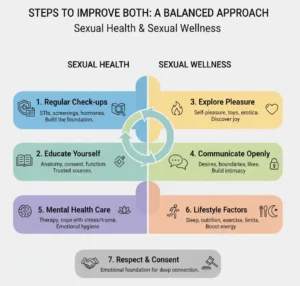And you know, I used to mix up sexual health and sexual wellness. I thought they were just fancy words for the same thing. Turns out, they’re related—but very different. Knowing the difference between sexual health and sexual wellness changed how I care for myself, how I talk about intimacy, and even how I connect with partners. Let’s dig into it, together.
Table of Content
What’s Sexually “Health” vs Sexually “Wellness”?
When we talk about the difference between sexual health and sexual wellness, it’s easy to think they mean the same thing—but they don’t.
Sexual Health refers to the physical, emotional, mental, and social aspects of one’s sexuality. The WHO defines it as a state of physical, emotional, mental, and social well-being in relation to sexuality, not merely the absence of disease or dysfunction (WHO data, 2022).
Sexual Wellness, on the other hand, is broader and more holistic. It includes sexual health, but it also touches on satisfaction, pleasure, relationships, self-esteem, personal identity, emotional boundaries, and ongoing growth. In simple terms, it’s about thriving, not just getting by.
Understanding this difference between sexual health and sexual wellness helps you see that one is about your physical and medical state, while the other focuses on your overall happiness and fulfillment in your intimate life.
Why This Difference Actually Matters
One of the biggest epiphanies I’ve had working as a sexual wellness coach is realizing how deeply the difference between sexual health and sexual wellness affects people’s intimate lives. Most people only think about sexual health when something goes wrong—like an STD scare, pain during sex, or fertility concerns—but they rarely think about sexual wellness until much later, or sometimes never at all.
That gap? It’s bigger than it seems. It can quietly lead to dissatisfaction, shame, frustration, and even anxiety in relationships.
If you only focus on treating symptoms—say, managing an infection or hormonal issue—you’re only handling part of the story. But if you never explore what brings you genuine pleasure, what your boundaries are, or how intimacy works for you emotionally and mentally, you’re missing out on the other side of that difference between sexual health and sexual wellness—the side that makes intimacy truly fulfilling.
Key Components of Sexual Health

Here are the pillars of sexual health. I’ll share real considerations from both medical and lived experience.
| Component | What it Includes | Examples |
|---|---|---|
| Physical health | STDs/STIs prevention, reproductive health, safe sex, anatomy, hormones | Getting tested regularly (HIV, HPV, chlamydia), dealing with hormonal imbalances, and managing pain during sex |
| Mental / Emotional health | Self-image, emotional safety, consent, trauma | Navigating body image concerns, healing from past abuse, and ensuring both partners feel safe and heard |
| Access to Resources | Healthcare, education, contraception | Access to condoms, safe abortion where legal, doulas, therapists, and sex-positive education |
| Rights & Ethics | Consent, non-discrimination, autonomy | Knowing your rights, getting consent, and being free from coercion or stigma |
For example, A few years back, I had a client who had recurring yeast infections—a physical issue, so part of sexual health. But what she also needed was emotional support, maybe education on self-care, how diet or stress plays a role, and communication with her partner. Without combining both, the infections kept coming back.
What Sexual Wellness Includes

When you start exploring the difference between sexual health and sexual wellness, you’ll notice that sexual wellness isn’t just about having “no problems.” It’s about flourishing—feeling alive, confident, and emotionally connected.
Here are some of the key pieces that make up true sexual wellness:
Pleasure. What turns you on? What gives you joy? What feels good (and the freedom to say “no” to what doesn’t).
Desire and libido. These naturally shift over time. Stress, sleep, hormones—they all play a role. Part of sexual wellness is learning to listen to your body and adjust gently.
Body image and confidence. Feeling comfortable in your own skin, embracing your shape, and understanding your sexual identity (orientation, gender identity, or preferences).
Communication with partners. Talking openly, setting healthy boundaries, and sharing what you like or don’t like. Real intimacy starts here.
Emotional connection. Trust, affection, and safety—these create the foundation for deep, fulfilling intimacy.
Mindfulness and mental well-being. Your mental state deeply affects your sexual wellness. Anxiety, depression, or unresolved trauma can lower desire or make it harder to enjoy intimacy.
Lifestyle factors. Sleep, nutrition, exercise, and stress management all directly impact how well you feel sexually.
In my own life, I’ve seen this difference clearly. During busy, burnout-heavy months, my sexual health was fine—no infections, no physical pain—but my wellness dipped. I felt drained, disconnected, and not in the mood. It took slowing down, sharing honest talks with my partner, and letting go of expectations to feel alive again.
That’s when I truly understood the difference between sexual health and sexual wellness—one keeps your body functioning, while the other keeps your desire, joy, and connection alive.
What Experts Say: Aligning Health & Wellness
When you really dig into the difference between sexual health and sexual wellness, it becomes clear that experts around the world see them as deeply connected—but not identical. I’ve looked at research, spoken with doctors, sex therapists, and sexual rights advocates, and here’s what they say.
According to the World Association for Sexual Health (WAS), sexual rights are considered essential to achieving true sexual health. This means that sexual wellness isn’t just about pleasure—it also includes access to information, freedom from discrimination, and the right to make informed, consensual choices about your body and desires.
According to a June 2024 study published in Frontiers in Psychology, sexual communication is central to relationship satisfaction. The research found that positive sexual communication is linked to higher relationship satisfaction for both men and women. This highlights how open, respectful conversations about desires and boundaries can deeply enhance both emotional and sexual connection between partners.
Certified sex therapists from organizations such as the American Association of Sexuality Educators, Counselors and Therapists (AASECT) often emphasize that focusing only on dysfunction (like erectile issues, low libido, or orgasm difficulty) without exploring the emotional or relational side usually leads to limited or temporary results.
In short, experts agree that sexual wellness builds upon sexual health. One doesn’t thrive without the other—and understanding the difference between sexual health and sexual wellness is the first step toward achieving both.
Difference Between Sexual Health and Sexual Wellness: Side-by-Side

To make this crystal clear, here’s a side-by-side comparison. I’ve noticed many clients get tripped up between the two, thinking they’re interchangeable. They’re not.
| Aspect | Sexual Health | Sexual Wellness |
|---|---|---|
| Primary Focus | Prevention, diagnosis, and treatment of physical/medical issues | Quality, satisfaction, emotional/relational fulfillment |
| Goal | Being free of disease, dysfunction, harm | Being full of pleasure, satisfaction, connection |
| Who’s Involved | Healthcare providers, clinicians, and labs | Therapists, self-care practices, communication with partner, lifestyle |
| Measurement | Lab results, absence of infection/pain, and fertility status | Satisfaction surveys, emotional well-being, communication, and relationship quality |
| Urgency vs Ongoing | Often reactive (treat when the issue arises) | Always ongoing—wellness is a journey |
Why People Confuse Them
Because in everyday talk, people loosely use “healthy sex life” to mean both. Or they reduce sexual wellness to only physical stuff—like STI prevention or orgasm. Shame, culture, and lack of education blur the lines. Even language plays a role: health sounds solid and measurable, while wellness feels vague or “fluffy.” But understanding the difference between sexual health and sexual wellness is essential. It’s what separates “I’m okay” from “I feel fulfilled.”
Steps to Improve Both: A Balanced Approach

So if you’re reading this and thinking, Okay, but what do I actually do? — Here are some practical, real-world steps.
- Get regular check-ups
Tests for STIs, pap smears, HPV screenings, hormone checks—this forms the base of your sexual health. You can’t build wellness without first ensuring your body’s in balance. - Educate yourself
Learn about anatomy, consent, and sexual function. Authoritative sources like WHO guidelines, Planned Parenthood, or local sexual health clinics can help. The more you know your body, the better you care for it. - Communication
Talk with your partner(s) about desires, boundaries, and pleasure. You’d be surprised how many issues dissolve once someone finally says what they like—or don’t. - Explore pleasure
Self-pleasure isn’t shameful—it’s education through sensation. Toys, mindfulness, or erotica—if it’s safe and consensual, it’s part of building wellness. - Mental health care
Stress, anxiety, or past trauma can all affect intimacy. Seeing a therapist or counselor isn’t indulgence; it’s emotional hygiene that supports sexual wellness. - Lifestyle
Sleep, nutrition, exercise, and limiting alcohol or smoking directly impact hormones, energy, and mood—all key to maintaining both sexual health and sexual wellness. - Respect and consent
These aren’t just rules—they’re the emotional foundation. Feeling safe and respected lets you relax and experience intimacy more deeply. - Community and resources
Learn from trusted experts, real stories, or certified brands (like OEKO-TEX-certified toys or medical-grade materials). Follow accredited clinics or organizations to ensure reliable guidance.
Sometimes, one small shift triggers a ripple effect. Better sleep → better mood → more openness about intimacy → stronger connection → improved wellness. That’s the magic balance between sexual health and sexual wellness in motion.
Measuring Progress
So how do you know you’re actually improving your sexual wellness? I like to ask myself a few simple but revealing questions:
Do I feel safe, connected, and heard during intimacy?
Am I enjoying sex more often—or in new ways?
Do I feel more confident about my body, desires, and boundaries?
Do I get regular health screenings without dread or avoidance?
Try keeping a small journal if that helps. You’ll start to notice patterns—maybe your wellness dips after stressful weeks, or maybe your libido spikes when you’re well-rested. Awareness itself is powerful. It’s not about perfection; it’s about progress.
Intersection: Where Health Meets Wellness
Here’s the truth: sometimes, the line difference between sexual health and sexual wellness blurs—and that’s perfectly okay. They’re not separate worlds; they overlap deeply and feed into each other.
A hormonal imbalance (a health issue) can cause low libido (a wellness issue).
Physical injury or pain can impact your emotional intimacy.
Mental health struggles like depression can affect physical health, leading to fatigue or reduced desire.
When you treat sexual health and sexual wellness together, you create synergy. You heal faster, deeper, and more completely. It’s the mind-body connection at its best.
Common Myths (Let’s Bust a Few)
Myth: Sexual health is just about disease.
Truth: It’s also about reproduction, emotional safety, function, and pleasure.
Myth: Sexual wellness is only about pleasure or sex acts.
Truth: It’s emotional, relational, mental, and even spiritual for many people.
Myth: If my sexual health is good, wellness will automatically follow.
Truth: Not always. Wellness requires intentional effort, reflection, and connection.
Myth: Sexual wellness only matters for people in relationships.
Truth: Not at all! Solo individuals, asexual folks, and single people all deserve to feel sexually well, too.
What’s “Latest”? Recent Insights (2023–2025)
To keep things fresh and research-backed, here’s what recent trends and studies show about the difference between sexual health and sexual wellness:
Telehealth is expanding — More people now access sexual health services through virtual consultations. It’s been a game-changer for those in remote areas or facing stigma.
Mindfulness-based sex therapy — Studies (2022–2024) show it helps both sexual health (reducing pain, improving arousal) and wellness (enhancing satisfaction and intimacy).
Safety standards in sexual wellness products — From medical-grade silicone to OEKO-TEX-certified materials, consumers are demanding safer, more transparent options.
Sleep and sexual desire connection — Research in the Journal of Sexual Medicine (2023) links poor sleep to reduced desire and greater dysfunction risk.
Intersectional awareness — Experts now explore how race, disability, culture, and gender identity uniquely shape both sexual health and sexual wellness experiences.
The one-size-fits-all model? It’s finally fading.
Brand / Certification Spotlight
Because not all sources are equal, I always recommend turning to verified and accredited ones:
Planned Parenthood and American Sexual Health Association (ASHA) — reliable for accurate sexual health education.
Sexual wellness products: Look for FDA clearance (U.S.), CE mark (EU), or certifications like OEKO-TEX to ensure body-safe materials.
Therapists: Seek professionals certified by AASECT (American Association of Sexuality Educators, Counselors and Therapists) if you’re considering therapy or coaching.
Using trusted brands and certified professionals keeps you safe, informed, and confident in your journey.
Summary: Difference Between Sexual Health and Sexual Wellness
Here’s the quick recap:
Sexual health = Being free from illness, having safe functioning, and getting the right care.
Sexual wellness = Thriving—feeling joy, connection, desire, and self-understanding.
You need both. Think of sexual health as the foundation of your house—and sexual wellness as the design, comfort, and flavor that make it home.
Practical Tips to Start Now
Here’s a mini 30-day challenge to help you balance both:
Week 1: Book a health check-up or self-screening.
Week 2: Identify one thing that increases your pleasure or desire—and explore it.
Week 3: Talk with your partner (or journal if you’re solo) about what feels good or what doesn’t.
Week 4: Improve one lifestyle habit—better sleep, less stress, more movement.
By the end of the month, notice how you feel. Often, small intentional steps in both sexual health and sexual wellness create big, lasting change.
The Bottom Line
Looking back, understanding the difference between sexual health and sexual wellness felt like learning to see in color after living in black & white. It opened doors: deeper intimacy, more fun, less shame. And yes, more pleasure. It’s a lifelong journey—not perfect, but always worth walking.
If you focus on health without ever caring for wellness, you might feel safe but not alive. If you care for wellness without health, you risk avoidable harm or sorrow. Combining both? That’s where real flourishing happens. And there’s no shame in starting wherever you are.
FAQs
Q1: What exactly is the difference between sexual health and sexual wellness?
The difference between sexual health and sexual wellness is that sexual health focuses on your body’s physical and medical well-being (disease prevention, reproductive function, safe sex), while sexual wellness includes that and your pleasure, emotional connection, self-esteem, confidence, desire. Health = foundation. Wellness = joy + thriving.
Q2: Can I have sexual wellness without perfect sexual health?
Yes. Many people have minor health issues but still experience high sexual wellness through joy, connection, communication, pleasure. However, untreated health problems may eventually dampen wellness. So caring for both helps.
Q3: How do I improve my sexual health and sexual wellness together?
Start with regular check-ups (STIs, reproductive, hormones), honest communication, exploring pleasure, caring for mental health, improving lifestyle (sleep, diet, stress), using trusted, safe products. Combining medical care with pleasure-focused practices is key.
Q4: What role does mental health play?
A huge one. Anxiety, depression, past trauma affect desire, pleasure, comfort, ability to communicate. Mental wellness is deeply tied to both sexual health and sexual wellness.
Q5: Are there resources to learn more or get help?
Absolutely. Reputable sources include WHO guidelines, Planned Parenthood, ASHA, sex therapists certified by AASECT or local equivalent. Also articles like sexual wellness trends for couples, sexual wellness habits for mental health support, stress-reducing habits that support female sexual health can add deeper insight. (See internal links below.)




